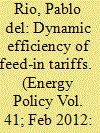| Srl | Item |
| 1 |
ID:
111322


|
|
|
|
|
| Publication |
2012.
|
| Summary/Abstract |
Dynamic efficiency has received much less attention than the effectiveness and static efficiency criteria to assess policies to support electricity from renewable energy sources (RES-E). On the other hand, the literature on RES-E support shows that the choice of design elements within RES-E support instruments is at least as important to successfully promote RES-E as the choice of specific instruments. The aim of this paper is to build a theoretical framework for dynamic efficiency analysis and assess the dynamic efficiency properties of the different design elements of feed-in tariffs. It is shown that, in fact, several design elements can have a significant impact on the different dimensions of dynamic efficiency. Particularly relevant design elements in this context are technology-specific fixed-tariffs, floor prices, degression, reductions of support over time for existing plants, long duration of support and support falling on consumers. In addition, it is shown than some design elements would be more appropriate than others to activate specific dimensions.
|
|
|
|
|
|
|
|
|
|
|
|
|
|
|
|
| 2 |
ID:
128048


|
|
|
|
|
| Publication |
2014.
|
| Summary/Abstract |
Decision makers facing abatement targets need to decide which abatement measures to implement, and in which order. Measure-explicit marginal abatement cost curves depict the cost and abating potential of available mitigation options. Using a simple intertemporal optimization model, we demonstrate why this information is not sufficient to design emission reduction strategies. Because the measures required to achieve ambitious emission reductions cannot be implemented overnight, the optimal strategy to reach a short-term target depends on longer-term targets. For instance, the best strategy to achieve European's ?20% by 2020 target may be to implement some expensive, high-potential, and long-to-implement options required to meet the ?75% by 2050 target. Using just the cheapest abatement options to reach the 2020 target can create a carbon-intensive lock-in and make the 2050 target too expensive to reach. Designing mitigation policies requires information on the speed at which various measures to curb greenhouse gas emissions can be implemented, in addition to the information on the costs and potential of such measures provided by marginal abatement cost curves.
|
|
|
|
|
|
|
|
|
|
|
|
|
|
|
|